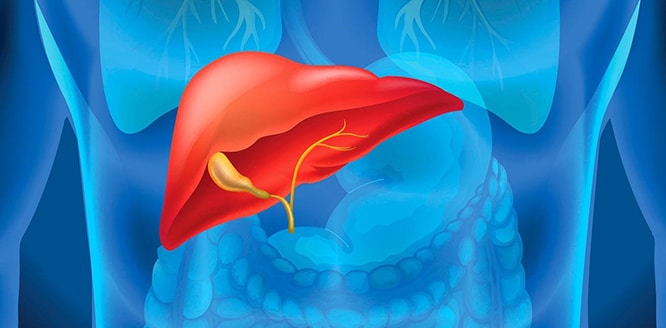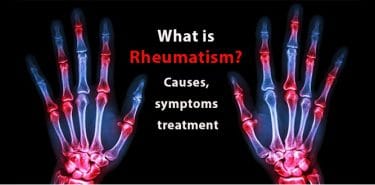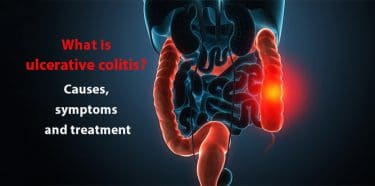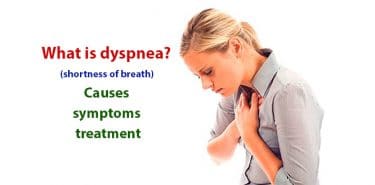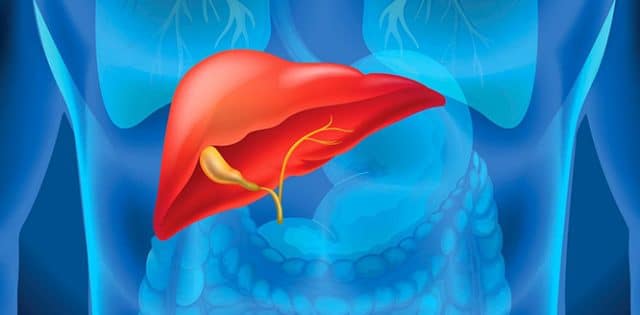
Table of Contents
What is cirrhosis?
Cirrhosis is a permanent disorder caused by a long-term damage in the liver. The damage results in the formation of a non-functional tissue called a scar tissue in the liver. Scar tissue prevents blood flow through the liver, and slows down the liver’s ability to process nutrients, medicines, and toxins. Cirrhosis can eventually lead to liver failure, which can be fatal.
However, it usually takes years for the condition to reach this stage, and treatment can help slow down the progression of cirrhosis. Many complications may occur in cirrhosis patients and life expectancy is significantly shortened.
Causes of cirrhosis
A wide variety of diseases and conditions can damage the liver and cause cirrhosis. The most common causes of cirrhosis include:
- Heavy alcohol consumption
- Chronic viral inflammation of the liver (viral hepatitis): especially hepatitis C and B
- Diabetes-related fatty liver
- NASH (Non-alcoholic steatohepatitis): It is a type of non-alcoholic hepatitis where the liver is inflamed as a result of excessive fat accumulation.
- Hemochromatosis: An inherited disease that causes iron build-up in the body
- Wilson’s disease: A familial disease characterized by copper deposition in the liver
- Alpha-1 antitrypsin deficiency: Absence of a specific enzyme in the liver
- Hereditary disorders of sugar metabolism (galactosemia or glycogen disease)
- Genetic digestive disorder (Alagille syndrome)
- Cystic fibrosis
- Infections such as syphilis or brucellosis
- Liver autoimmune diseases (chronic conditions in which the body’s own immune system attacks the liver or bile duct cells), for example: autoimmune hepatitis (liver disease caused by the body’s immune system attacking liver cells), primary biliary cirrhosis (destruction of bile ducts) and primary sclerosing cholangitis (scarring and hardening of bile channels)
- Some drugs such as methotrexate or isoniazid
- Obstruction of the bile duct
- Fluid accumulates in the liver and causes blockage as a result of repeated heart attacks and heart failure.
- Excessive intake of liver-damaging drugs such as paracetamol and vitamin A
Drinking too much alcohol can damage liver cells. Alcohol-induced cirrhosis usually develops after 10 or more years of heavy alcohol consumption. Women who consume heavy alcohol develops liver damage easier than men. Other causes of cirrhosis include reactions to prescribed drugs in the body, prolonged exposure to environmental toxins, and infections caused by parasites.
How to prevent cirrhosis naturally?
Reduce alcohol intake
The best way to prevent alcohol-related cirrhosis is to drink within the recommended limits:
- No more than 14 units of alcohol (7 liters of beer) should be taken per week.
- The amount should be distributed to three or more days.
- Those diagnosed with alcohol-related cirrhosis should stop drinking immediately. Alcohol intake, regardless of the cause, causes cirrhosis to progress rapidly.
Protect from hepatitis B and C
Hepatitis B and C are infections that are transmitted by close contact, such as unprotected sexual intercourse or the use of common injectors. The best way to prevent hepatitis B is to get a vaccine. However, there is no vaccine developed for hepatitis C yet. Using condoms during intercourse and avoiding drug injections reduces the risk of hepatitis B and C transmission.
Have a healthy body weight
In order to reduce the risk of developing non-alcoholic fatty liver disease that may cause cirrhosis, you should have a healthy, balanced diet and a healthy body weight with the help of regular exercise. If you are concerned that you have the risk of liver cirrhosis, talk to your doctor about the ways to reduce the risk.
What is the average age of cirrhosis? Can kids get cirrhosis?
It may occur due to various inherited diseases such as Wilson’s disease, cystic fibrosis, biliary atresia. Biliary atresia is absence of bile duct from birth and is a very important cause of cirrhosis in children. Non-alcoholic inflammatory fatty liver is a condition that can cause cirrhosis in youth.
Cirrhosis types and stages
Cirrhosis is divided into three groups according to the condition of the liver and the nodules being formed:
- Micronodular cirrhosis: Cirrhosis type with nodules less than 3 mm in diameter. Alcoholic cirrhosis belongs to this group.
- Macronodular cirrhosis: Nodules vary in diameter from 3 to 5 mm. Cirrhosis due to chronic viral hepatitis belongs to this group.
- Mixed type: It has cirrhosis characteristics of both types. The liver looks like this in most cirrhotic diseases.
Stages of cirrhosis
The liver is injured and scar tissue is formed as a result of long-term alcohol consumption or viral infections. A scarred liver cannot function properly and cirrhosis occurs. Cirrhosis causes the liver to contract and harden.
Hardening of the liver cells makes it difficult for the blood rich in nutrients to flow from the vein to the liver. A portal vein is a vessel that transports blood containing nutrients absorbed from the digestive tract to the liver. Pressure in this vessel increases when blood cannot be delivered to the liver.
The result is a serious health condition called portal hypertension, where high blood pressure develops in this vein. High pressure causes vascular enlargement (varicose veins) which may end up with rupture and bleeding in the esophagus and stomach.
Symptoms of cirrhosis
- Fatigue
- Weakness
- Nausea
- Unexplained weight loss and loss of appetite
As cirrhosis progresses, the following symptoms may be observed:
- Jaundice (Yellow color in skin and eyes)
- Blood Vomiting
- Itching of the skin
- Dark color urine
- Light colored stool
- Blood in stool
- Easy bleeding in the body
- Nose bleeding
- Bleeding and bruising of the gums
- Easy bruising on skin
- Redness of palms
- Painful edema in the legs
- Formation of spider-like blood vessels in the skin
- Abdominal fluid accumulation (Acidic)
- Discontinuation of menstrual bleeding in women (not associated with menopause)
- Loss of libido in men, breast enlargement (gynecomastia) and testicular shrinkage
- Confusion, sleep and speech impairment (hepatic encephalopathy)
Diagnosis of cirrhosis
If your doctor suspects cirrhosis, he/she will question your medical history and perform a physical examination to look for long-term liver disease symptoms. Some tests and imaging methods can be used to confirm the diagnosis:
- Blood tests: Liver function tests measuring liver enzymes, blood clotting tests, albumin level (a protein produced in the liver), alpha feto protein measurement for liver cancer screening
- Liver ultrasonography
- Magnetic resonance imaging of the abdomen
- Abdominal CT
- Liver biopsy (a part is taken out from the liver tissue with the help of a small needle and examined under a microscope.)
- Endoscopy: A thin, flexible tubular device (endoscope) with light and camera at the end is pushed down your throat. Endoscopy examines the esophagus and stomach. Swollen vessels (varicose veins) present here the signs of cirrhosis.
Ultrasonography, computed tomography (CT) and magnetic resonance imaging (MRI) are not sensitive to detect cirrhosis, therefore the definitive diagnosis is still based on biopsy.
Treatment of cirrhosis
There is no definitive treatment for cirrhosis. However, some treatments can slow down the effects and complications of the disease. Treatment of the underlying causes, such as using anti-viral drugs to treat hepatitis C infection, can stop the worsening of cirrhosis. Removal of triggers that cause cirrhosis can delay progression and reduce the risk of liver cancer.
Weight loss or quitting alcohol consumption will slow the progression of cirrhosis. A wide range of support services are available for alcohol addiction. When the liver is severely damaged, it may no longer function. In this case, liver transplantation remains the only treatment option.
Cirrhosis medications
- Beta blockers or nitrate group blood pressure medications for portal hypertension
- Intravenous antibiotics for peritonitis
- Lactulose and low protein diet if hepatic encephalopathy is developed
- Antiviral treatments for hepatitis b, c and d
- Avoiding to use certain medications that may make symptoms worse such as paracetamol, ibuprofen
Liver transplantation
The final treatment for cirrhosis and end-stage liver disease is liver transplantation. A major advance in liver transplantation is the development of immunosuppressive drugs used to prevent organ rejection. Thus, tissue loss due to the organ rejection of the body is relatively rare. Recurrence of cirrhosis after liver transplantation, especially the long-term results of immunosuppressive agents such as hepatitis C infection, hypertension, hyperlipidemia and kidney disease, are important problems.
Complications of cirrhosis
- Portal hypertension: High blood pressure occurs in the blood vessels that deliver blood to the liver.
- Swelling of the legs and abdomen: Increased pressure in the portal vein can cause fluid accumulation in the legs (edema) and abdomen (acid).
- Growth of the spleen (splenomegaly): Portal hypertension can cause the spleen to change and swelling, and platelets in the spleen to mount up.
- Bleeding: Portal hypertension can cause blood to be directed to smaller vessels. When forced by extra pressure, these small vessels may explode and cause severe bleeding. In addition, varicose veins and blood clotting disorders can be seen.
- Infections: The immune system weakens in patients with cirrhosis, and the body has difficulty fighting with infections. Accumulation of fluid in the abdomen can lead to a serious infection, bacterial peritonitis.
- Malnutrition: Cirrhosis makes it difficult for the body to process nutrients. This results in weight loss.
- Accumulation of toxins in the brain (hepatic encephalopathy): A liver damaged by cirrhosis cannot remove toxins from the blood. These toxins accumulating in the brain, cause blurring of consciousness and neurological symptoms that can lead to coma.
- Jaundice: The diseased liver occurs when it cannot remove ‘bilirubin’ the waste product from the blood. Bilirubin causes the skin and eye whites to turn yellow and urine to darken.
- Bone disease: Bone resistance decreases in people with cirrhosis, and fracture risk increases.
- Multiple organ failure
- Liver cancer: It is one of the most common cancer types in the world and cirrhosis is the main risk factor for liver cancer.
Herbal treatment for cirrhosis
Research has shown that the benefits of plants that have become popular in the treatment of cirrhosis or other diseases are often very lacking. Also people with liver disease should be especially careful about plants. Because the liver processes everything that enters your body. Therefore, before starting any herbal treatment for cirrhosis, consult your doctor!
Suggestions for cirrhosis patients
- Do not use alcohol. Alcohol makes your liver damage worse.
- Maintain your healthy weight.
- Reduce salt. Excessive salt can cause edema in your body, and swelling of your stomach and legs.
- Cirrhosis causes malnutrition. You can cope with this by adopting a vegetable-based diet rich in fruits and vegetables. Prefer lean proteins such as legumes, poultry or fish. Do not eat raw seafood.
- Protect yourself from infections. Cirrhosis weakens your immune system. Wash your hands frequently and avoid to be in a close contact with sick people. Get a vaccine for hepatitis A and B, influenza and pneumonia.
- Cirrhosis makes it difficult for your liver to handle drugs. Therefore, ask your doctor before taking any medicines, including over-the-counter medications. Avoid aspirin and ibuprofen drugs. If you have liver damage, you may need to avoid acetaminophen (Tylenol, others) or use low-dose painkillers.
References: 1- Cirrhosis, 2- Liver Cirrhosis, 3- Cirrhosis of the liver

